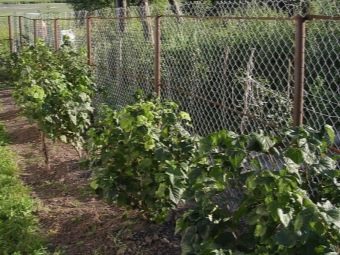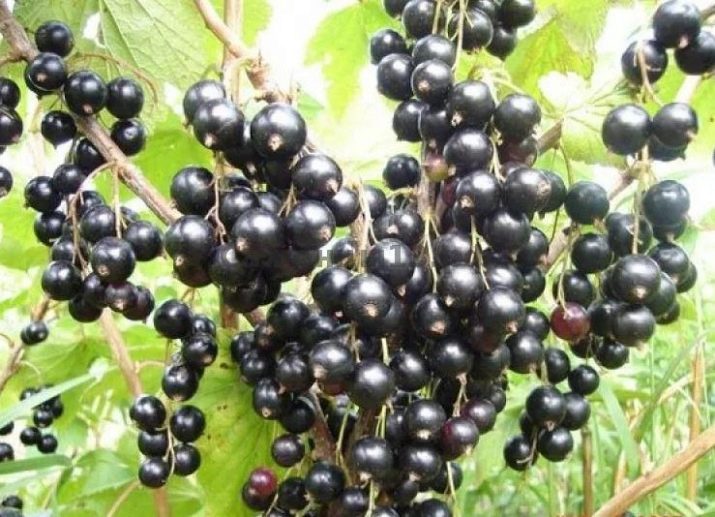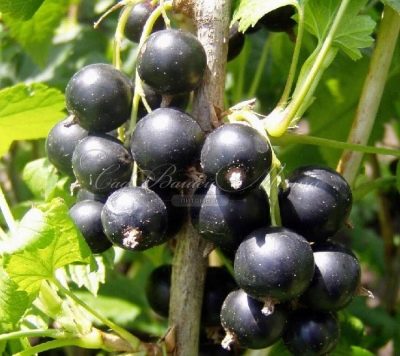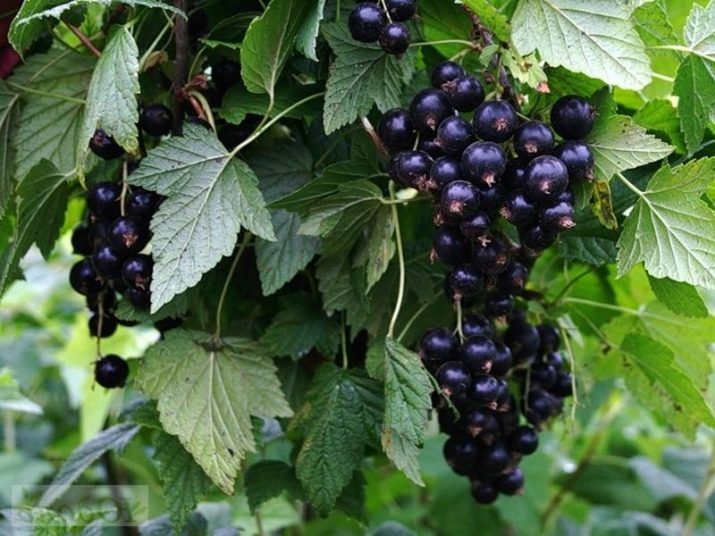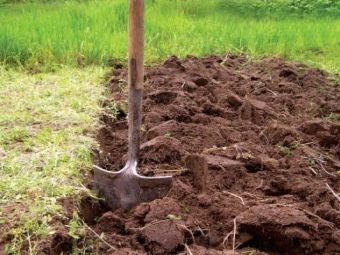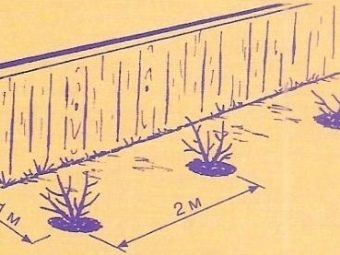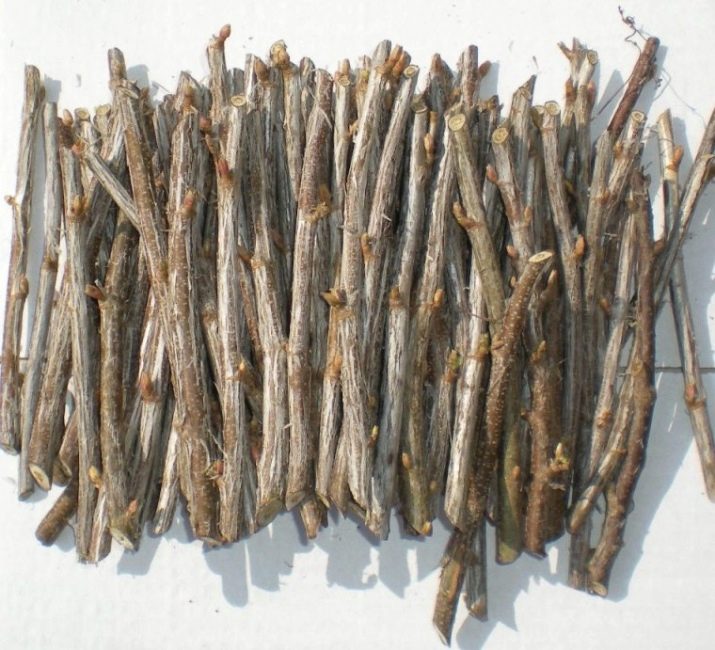Features of growing currants
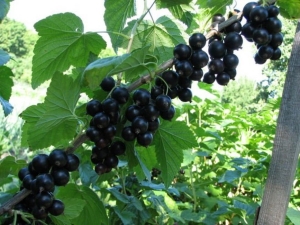
Black currant is a plant with extremely tasty and healthy berries.It is so popular in our country that at least one bush grows in almost every summer cottage.
For the first time it began to grow in the tenth century in Kievan Rus in the gardens of the monasteries, and later it appeared in Europe.
Currant is tasty and raw, "from the bush", and processed - it makes excellent jam, jam, jam, juice. It can be frozen, while it does not lose taste. Defrost it should be as needed and use, for example, as a filling for the cake. This is delicious. Fresh currants can be ground in a blender and make smoothies. In addition, black currants are used in winemaking.
Timing
Black currant comes from the gooseberry family.
Its root system is formed by highly branched, fibrous roots, which grow 20 deep into the soil, or even 40 cm. The bush itself is formed by a large number of different-level branches of different ages. That is why the bush can successfully bear fruit for about 15 years. The most productive - usually the sixth and seventh years of life of the bush.
In spring, swelling of currant buds occurs early - as soon as the temperature rises above +5 degrees. The bush begins to bloom in the range of + 11-15 degrees, and because of this, it is often struck by spring frosts.
Most currant varieties are self-fertile, they do not need special pollination, and they are resistant to frost. Nevertheless, it is better if different varieties grow alongside, cross-pollination increases both quantitative and qualitative indicator of the harvest.
Currant is a plant that uses not only berries, but also leaves; they have such a strong and pleasant aroma that you can use them both in canned raw and dried in tea compositions. Currant berries contain a very large amount of vitamin C, therefore, contraindicated in persons suffering from diseases of the gastrointestinal tract.
Black currant has a huge number of varieties. Let us briefly discuss the most common among gardeners.
- "Belarusian sweet" - early ripening variety, berries can be eaten in the beginning-middle of July. Additional pollination is not required, the fruits are large. Does not suffer from kidney mite and anthracnose.
- "The Eighth of Davison" grows in almost all climatic latitudes, excluding the northernmost ones. Bushes are medium sized and medium sized. The berries are large and very sweet, the leaves have a curved shape.
- "Boskopsky giant" ripens in mid-July, the berries are large, have a pronounced acidity. Sprawling bushes, planted at a considerable distance.
- "Gross" ripens late, in late July-early August. Fruits have a very large size - up to 5 g each. Bush high, medium-sprawling. Treats dessert grades, productivity is high. It is well resistant to fungus, but suffers from kidney mite.
- "Kent" keeps up late. There are a lot of berries, they are big, they have strongly pronounced acidity. Spreading bushes small, height too.
- "Moscow" currant belongs to winter-hardy varieties. It ripens early, does not need additional pollination, it is self-bearing. The berries are large, but the amount of harvest from the bush is average. "Moscow" is resistant to the effects of kidney ticks and terry.
- "Oryol Serenade" ripens in late July. The berries are medium in size, but there are many of them on the bush. This variety is one of the most resistant to diseases and pests.
- "In memory of Potapenko" - bushes of this variety are sprawling, medium-sized, berries ripen in mid-July. The variety has very large fruits with a characteristic sweet taste. The crop is average, but the bushes are little susceptible to fungal infection and the effects of a kidney tick.
- "Premiere" - As the name implies, the variety is early follower. Bushes are high, berries are large, dessert taste. Harvest from the bushes is usually high. It suffers from powdery mildew, but is not affected by a kidney tick.
- Sort "Seaside Champion" It is called so completely deserved - its bushes are very powerful, and the berries are large. "Champion" received, crossing the "Aldan grapes" with "fertile Leah." A distinctive feature of the variety is the lack of currant smell in the berries. Fruits are large, may have both round and oval shape. Harvest high, ripen in early to mid-July, resistant to frost.
- "Treasure" - variety with low and compact bushes, but with large fruits. High yield, resistance to powdery mildew and kidney mite is medium.
- Some of the largest berries grow on the variety bushes. "Enchantress". The bush itself is also large. Berries have a dessert taste without sourness. The harvest is high, resistance to diseases and pests is good.
The above is only a small part of the wide range of currant varieties. Some of them can be grown even in northern latitudes, such as, for example, Neapolitan, Kent, Goliath, Boskopsky Giant and Leah Fertile.
Choice of place
Before planting a currant, you need to find a suitable place for it. This area should be well lit, but at the same time closed from the "walking" drafts and winds.
If on summer sunny days you realize that you have made a little mistake with the place and the currants are hot, it will start to fade, then you need to arrange a light shade for the bushes. You can build a homemade canopy or plant between the bushes (if the distance allows) high-growing annual plants. It could be a sunflower, corn or something else.
Before planting currant bushes, you need to prepare the soil. This is easy to do - fertilizers need to be applied in such a way that about 10 kg of humus, 60-70 g of superphosphate top-dressing and 1 l of ash fall on each m2 of land on which the bushes grow. After making the feeding you need to dig up the ground. The depth of digging should not exceed 0.25 m.
When planting bushes, you need to immediately leave the correct distance between them so that, if they grow, they do not overshadow the sun, or intertwine with branches. For each type of currant has its own planting density, taking into account the spreading of bushes.
If the variety is upright and low sprawling, the distance between the bushes in a row should not be less than 1 m, and between rows should be 1.5 m. much bigger.
Soil with high acidity - not for currants, she does not like this. If the soil in your garden is of this type, you need to liming it.
In the lowlands, where the ground is too saturated with moisture, the currant will also not grow, and if it does, it will not produce fruit of good quality.
How to plant?
Black currant - a plant very common in our country. That is why every gardener can get acquainted with the methods of planting if desired. Terms of planting currants - or early spring, or late autumn.
The depth of the planting hole under the currant bush is about 0.4 m, and the diameter is 0.5 m. If the soil was fertilized before digging, fertilizer should not be applied before planting. If fertilizing is not made, in each well you need to put about 5 kg of humus, a liter of ash, as well as about 150 g of superphosphate fertilizer. Feed must be mixed with soil.
The seedlings are placed in the open ground at an angle of 45 degrees, in addition, they should sit a little deeper (5-6 cm) than they initially grew. Planting in a similar way helps the growth of roots and shoots.
The soil around the planting should be watered abundantly and preferably mulched. It is better if humus comes out as mulch, but sawdust or peat can also be used. At the worst, dry soil is also suitable, but it is better to take care and find a good mulch.
After planting, seedlings need to be cut, leaving only a few strong buds - three or four.
Many gardeners are of the opinion that it is better to plant currants in the autumn, about a month before the onset of frost.
Care
Black currant is one of the plants, which is easy to care for. Seasoned gardeners say that this particular shrub is one of the relatively unpretentious. However, care must be thorough and systematic. If you need large and tasty berries, healthy bushes, then this will have to take care. Without help, the currant will not grow and will not bear fruit abundantly.
Unfortunately, this shrub is very susceptible to the effects of pests and fungus, so prevention and treatment should be carried out regularly.
If the bushes struck kidney mite, you need to collect all the kidneys affected by this pest, his hands and burn them. If powdery mildew has settled on the currant, you will have to use sulfur preparations or poisonous vegetable decoction.
Let us dwell a little more on the question of the reproduction of currants. Recently, the number of pests attacking gardens has increased, as well as the intensity of the diseases that bushes are exposed to. Grow healthy and high-quality seedlings is not easy. That is why the so-called "elite" cuttings are very valuable. Plantations in which they are grown, by all means protect against the likelihood of penetration of pests and infection of diseases.
The quality and quantity of the crop primarily depends on the seedlings. Gardeners do not recommend growing the currants from seeds, because the seeds inherit everything - both good and bad properties of their variety, so the bush does not always grow healthy. The most suitable for breeding currants are three ways:
- layering;
- cuttings;
- division of the bush.
Rooting cuttings - the least time-consuming method of reproduction of black currant. For cuttings are best shoots radical or annual, reaching the first order of branching. The length of the cutting should not exceed 20 cm, width - 7-10 mm. Cut it always very sharply sharpened with a knife. The cut should be 1.5 cm above the place where the kidney is located, because roots will form in it.
September and the first week of October is the best time to make cuttings.
If you are not too lazy and planted in the autumn of cuttings, then in March or April, before bud break, they will have the first roots. You can plant cuttings in the spring, when stable warm weather is established, and the soil temperature will be about +8 degrees.
For planting, you need to choose a plot in the country without hollows and hills, as well as where winds and drafts will not walk. Before planting the soil requires watering. Landing is made at the same distance. It is necessary to pour fertilizer into the well in the proportion mentioned above. Between cuttings there should be about 0.7 m. If you plan to plant cuttings in rows, then between them there should be 0.2 m.
After the stalk is placed in the ground, it is necessary to compact the soil around it, and it is better to mulch. Further, the standard care - loosening, watering, weeding, fertilizer.
To divide the bush, the effort will need more. But this event is a one-time event, and there is no need for any storage and protection as with cuttings. This method is good in terms of time trouble, when it is urgent to spread currants.
Shrubs are divided by means of a saw or pruner. The separation should occur in such a way that each part of the bush retains a sufficient number of roots, branches and shoots. It is necessary to understand that reproduction in this way gives less chances for engraftment of parts of the bush than cuttings.
As for the layering, the guide to action here is to root a branch or escape, and to separate it from the “mother” bush after they take strong roots. Branches and shoots two years old are best for cuttings; they have the greatest chance of rooting. Of course, a shrub that is used as a parent must be healthy and prolific.
Before rooting cuttings, a number of activities should be carried out on the ground, namely: loosening, fertilizing and watering. Otherwise, the idea is doomed to failure, they will not give any roots of the branch.
It is possible to make cuttings horizontal, and can be vertical.
- The first ones are more common. The principle is this: the escape must be bent to the ground, then thoroughly sprinkled with earth. For the first time, the earth is sprinkled when the growth of shoots was more than 10 cm, and in the second - 14-21 days after the first. Digging is only needed when they have become full-fledged seedlings with a good root system.
- From vertical otvodki can get more seedlings. To get them, the old bush will not work, you only need a young one. All the upper branches are cut off from the bush, and then the root shoots begin to appear and grow rapidly from the buds in the lower part. As soon as they reach a height of 0.2 m, the soil around the bush is carefully loosened and spud earth. It should be wet. Loosening and watering will need to be systematically repeated until the fall. And then it will be possible to carefully separate the shoots with roots and plant them in the winter on their own.
In the spring
To have a good harvest, the bushes need to be fed every year. This is done in the spring, during the flowering of the currant, as well as when ovaries are formed on it.
Currant fertilizer perceives organic: manure or bird droppings, diluted with water.
Can be added to the wood ash solution. As for mineral supplements, ammonium nitrate, superphosphate fertilizer and potassium salts will do.
Summer residents who have been growing this crop for many years have recommended such a plan during the fertile season.
- In March-April, the bushes are fertilized with ammonium nitrate solution (30 g should fall under one plant) or urea (20 g, respectively).
- When the bushes have bloomed and the ovary began to form (in late May or early June, depending on the climate), poultry manure diluted in water at the rate of 1 part per 12 parts of water or cow dung at the rate of 1 part to 6 parts of water are introduced. Under each bush should fall one or one and a half buckets of organic fertilizer.
- After the berries are harvested, fertilizing is done, similar to spring. This is necessary in order to strengthen the bushes and formed new buds.
In order for the bushes to bear fruit evenly, they should not land near the building or fence. The part that will be pressed against the wall or boards will not give berries.
If you want the currant to bear fruits with large berries, plant several bushes of different varieties next to it. Due to cross-pollination, the fruits will be bigger and tastier.
In order not to confuse the age of shoots and branches and not to cut off the rash of the rash, you can mark them. By marking each shoot with the appropriate color or ribbon (thread), you will timely cut off the age branches.
Summer
The rest of the care is no different from the care of other plants. It includes weeding from weeds, loosening the soil, regular watering. Particularly often have to weed, if creeping wheat grass has settled near the currant.
Blackcurrant is moisture-loving, so it needs frequent watering. If the plant does not have enough water, then the berries become shallow, fall from the bush, and the growth of the shoots stops. Watering the bushes is better in the morning or in the evening, it is then that the soil temperature is optimal for watering.
Do not forget about the need to water the bushes even when you have already harvested them. Overdrying of plants during this period will cause them to freeze in winter. Key irrigations occur during periods such as:
- growth and formation of ovaries;
- pouring fruit;
- after harvest.
Let us dwell in a bit more detail on such an interesting event as currant inoculation. It would seem that this culture is one of the most common in the central territory of Russia, in Siberia and the Urals.To grow it, you do not need to overcome any obstacles, you can simply buy seedlings, plant, care for them and wait for the harvest. Why do we need to vaccinate it?
It turns out that grafting currant allows you to solve a number of problems.
- Rapid breeding of rare varieties. If you use basal shoots as a stock on currant bushes already growing in the garden, you can get enough seedlings of the desired variety in a sufficient amount of time.
- Quickly replace the old bush, without resorting to uprooting it. It often happens that the "age" or damaged bush remained strong roots. Then you can trim the entire “top” and plant the same variety or another on it.
- Improve the quality of the harvest of red currants. Grafting it on black currant, thus it is easy to increase both quantitative and qualitative indicator of yield, because black currant has much stronger roots. Having grafted “red into black”, you will get much more delicious berries than if red currants grow on your own roots.
- Growing currants on the trunk. First of all, this solution is very attractive from the point of view of the landscape - the standard bush looks unusual and modern, it can be entered into the garden composition and at the same time it will bear fruit. And secondly, it also leads to an increase in the yield of the bush.
The practice of gardeners involves vaccination either in early spring or in summer during the growing season. The term depends on the goal pursued by the gardener, as well as what material for the scion he has.
In the spring, the grafting is done through lignified cuttings that are prepared in autumn or in winter. The specific period of spring vaccination depends on the weather, but usually this is the last decade of March. It is important to “catch” the period between the start of sap flow in the rootstock and bud break. To accurately determine whether the movement of juices began, you need to cut the branch and see if the crust is moving well. If so, the juices began to move and you can be vaccinated.
If you decide to inoculate a shrub in the way of budding, then it is better to choose summer for this, because then it is better to see the condition of the buds and shoots, as well as the graft survival process. In the southern regions, you can apply budding and in the spring, then you need to choose a non-solar plot on the stock.
For vaccination in the spring need cuttings from lignified young shoots aged one year. They must be formed kidneys. It is better to use the shoots from the south side of the bush, not from the root and not from its upper parts.
It is necessary to prepare cuttings in the autumn because the spring may turn out to be frozen and not settle down. The shoots prepared in autumn will be healthy, respectively, the degree of their survival will be higher. Although in the southern regions spring pruning of cuttings is also possible just before grafting.
If the vaccination is done correctly, after 60 days, the graft and stock should grow together. This, in the first place, is evident from the state of the grafted cutting - the buds bloom on it, it goes into active growth. It is important to carefully ensure that the grafted bush is not attacked by diseases and pests, they are very fond of weakened plants (and after vaccination they are just that). If it is possible, it is better not to remove the harness for longer than the prescribed period, so the risk of breaking the cutting is reduced.
For vaccination to be successful, you need to follow a number of rules.
- Right to choose the time of vaccination. If you make it earlier than necessary, the stock will have nothing to feed the graft, since the juices will not move yet. The graft will dry and die. If you get a vaccination later, the inoculum is likely to be rejected.
- Choose the right stock. It should not be planted "anyhow", not all varieties and types of currants are in good contact with each other. Before grafting something, you should examine the compatibility of the selected stock with the desired types of graft.
- Observe vaccination technology. The knife must be very sharp, all actions are performed very quickly and accurately. The binding material must be airtight and of high quality. After the vaccination is done, you need to protect the junction from drying out, hypothermia, diseases.
To graft currants, suitable golden, black and red currants, gooseberries. Although in the case of gooseberries, it is better to graft it on currants rather than currants on it. If you decide to be vaccinated on a cherry or mountain ash, you need to consider that in the first case, the result can be quite interesting, but the survival rate of the cuttings is average. As for the mountain ash, it is recommended to use it only when there is nothing more to be vaccinated: in this case, the survival rate is low, and the graft is bad.
The best option - golden currant. It is much less whimsical than black, an additional plus - it is on the golden currant that the stem bush is best formed.
In the autumn
In addition to the above, currant bushes need to be cut and shaped. This is perhaps the most time-consuming and difficult event to care for her.
There is an erroneous opinion that if there are many shoots on a currant, then the harvest will be large. In fact, the abundance and quality of the harvest depends on how strong last year's shoots. The most fruitful branches of the so-called "skeleton" of the bush, their age - from 2 to 3 years.
For the first time the bush is pruned immediately after disembarkation. It is necessary to cut off all the shoots, leaving some of the most powerful. Then within a few years you need to remove weak branches, as well as those that are broken or dried. A bush is completely formed only at the age of three or four years. If the roots of the shoots are formed poorly, then you need to cut five or six skeletal branches to grow shoots more intensively. A well-formed plant has about 10-12 branches. All branches have different ages.
Branches at the age of 5 years, which are weak and poorly fruited, are pruned annually. The best time for pruning is early spring, before the bud breaks. As a rule, this is March or early April. If pruning is done correctly, the root shoots will grow strong, powerful, well branched. In addition to the above, due to pruning, the bush is well lit and ventilated, which gives rise to a harvest.
An indication that you are doing everything correctly is that in the fourth or fifth year of the bush’s life it has about 15–20 strong “skeletal” shoots. They are also cut for sanitary and anti-aging purposes every year.
Of course, different varieties of currants have a different growth rate, fruiting period and the degree of yield. That is why there are three conditional groups for trimming methods.
- Grades of the first group annually emit a large number of basal young shoots, while their ability to branch is weak. Therefore, they are cut by one third each, it helps the branches to branch. As soon as the shoot reaches the age of 4 years, it is cut off “to zero”.
- In varieties belonging to the second group, on the contrary, young shoots from the root grow poorly, they are few. In this case, the branches of the skeleton have excellent ability to branch. Therefore, to form a bush in which branches of different ages would be combined is difficult. To adjust this, basal shoots are not pruned, and old branches are cut. Do not feel sorry even fertile branches. The average life of a branch on these varieties is 5 years, after which it is cut.
- With regard to varieties classified in the third group, they represent an arithmetic average between the varieties of the first and second groups. Their branches are moderately branched, and basal shoots are moderately formed. The life of the branch is about 6 years, after which it is completely cut off.
Before the onset of cold weather, you should also pour plenty of currant bushes. Then the plants will harden and strengthen, which will positively affect their winter hardiness.
Diseases and pests
Like almost any plant, black currant has its own “garden” enemies - these are diseases and pests. They need to be fought if you want to maintain healthy powerful bushes and increase the quality and quantity of the crop. Control and prevention measures consist of constant adherence to the rules of agricultural engineering.
Naturally, it is not enough to care only for currants, you need to take preventive measures to protect all garden plants from pests, fungus and other problems. But a well-kept garden means that nothing will disturb the normal growth and development of plants. But even carrying out constant care, it is difficult to protect plants from enemies. First, they can “climb” from a nearby vegetable garden, where the owners are not so attentive. Secondly, some seedlings may initially have flaws.
Speaking of diseases that black currants usually suffer from, powdery mildew (due to which planting of this crop is forbidden in the US), anthracosis, double bedrock, cuprock rust, white spotting should be noted.
Any of these diseases can cause significant damage to currant bushes, worsen both the decorative properties of the plant and the crop in quantitative and qualitative indicators. In addition to disease, there are also pests that are also striving to harm currants. These include goldfish, leaf gall midge, currant bud mite, spider mite, moth, sawfly, glass bowl, peppered moth, and escaped aphids. Any of them is enough to cause irreparable damage to the currant bush, and if you do not notice their destructive activities in time and do not take measures to combat them, the bush will most likely have to be uprooted and burned.
Any gardener, especially a beginner, should remember the advice: treating the bush with chemical preparations is the simplest thing to do.
However, these compounds are dangerous for pests as well as for leaves, berries and branches. Therefore, noting that the plant showed traces of pests or signs of disease, you need not be lazy and manually process all the damaged elements of the bush. Step-by-step instruction will be as follows: you need to cut off the leaves and branches, collect the larvae and traces of insects, and burn it all.
Next, you need to treat the bushes with vegetable decoctions that do not harm the currants, but only fight against diseases and insects. And only if you are convinced that nothing helps, you need to proceed to the use of toxic chemicals.
When using insecticides, it is necessary to use personal protective equipment in order to avoid poisoning of the body: wear protective glasses, gloves, a specialized suit and a hat.
On how to properly care for and plant currants, see the following video.


